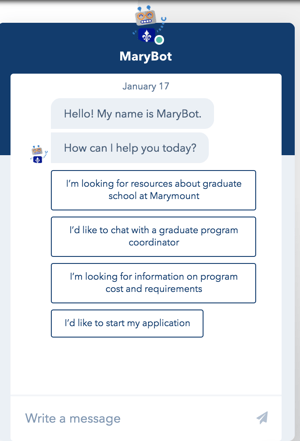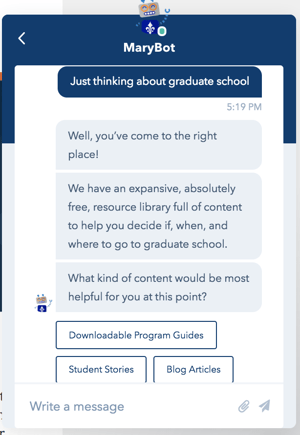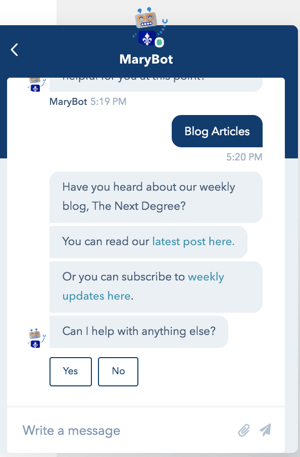It seems like it would be difficult to narrow down exactly what matters most to each prospective graduate student, but it is not! By utilizing advanced marketing technology platforms such as HubSpot, institutions and enrollment managers can view their prospects’ patterns of behavior and engagement. By analyzing this information, enrollment managers can determine what likely matters to an individual and can then begin providing a specifically tailored content and outreach plan, that will nurture them toward application.
For example, through HubSpot you (an enrollment manager) see that one particular individual has returned several times to your Master of Computer Science program page, and they have also visited the financial aid page and filled out a form to request more information. Based on this information, it would be wise to send them your digital resource on the Master of Computer Science program, and a friendly email inviting them to check out three of your blogs on financing their graduate degree.
Read on for more information about how you can determine, and act on, what matters most to a prospective grad student in 2020.
The 2020 Graduate Student Rubric
What matters to each particular graduate student is different based on their needs, interests, field of study, and many other factors. The best way to tell what is most important to prospective students, is to track their movements within your website and learn from the pages they spend the most time on, the content they interact with, and the resources they download.
Although the order of these factors could vary greatly from student-to-student, this encompasses what generally matters the most to prospective graduate students:
- Curriculum
- Cost
- Research Opportunities
- Internship/Field Placement Opportunities
- Current Student Recommendations
- Industry/Alumni Network
- Location
- Available Student Resources/Facilities
- Closeness of Community
- Faculty Qualifications
Student’s Expectations of Institutions
When a student is researching and vetting a potential graduate school, there are several things that they expect of the institution. It is important for enrollment managers to take these factors into consideration when designing their website, creating content, and mailing prospective students information.
Students expect, first and foremost, ease of access to information. If a student has to spend a great deal of time and effort trying to locate the information they need - they will most likely move on to another website and another school. It is crucially important that all a school’s online resources are developed and organized with user experience in mind.
Leveraging Marketing Tech: If a user is a contact that already exists in your school’s CRM, and their session time is less than 30 seconds, trigger an email that asks if their questions have been fully answered.
Prospective students also want to see clarity of program requirements and outcomes in the beginning stages of their grad school search. Student’s want to know exactly what (and how long) it will take to graduate, and what kinds of professional prospects they will have upon graduation.
Leveraging Marketing Tech: Create a smart list that pulls in all contacts in your database who search for “program requirements/outcomes” on your website or highlight these words with their computer mouse (yes, you can do that!). Then create a workflow — using your marketing automation platform — that sends these folks 2-3 alumni testimonials about the short term and long term ROI of the particular program.
With rising student debt and the financial concerns that many current graduate school applicants have in these areas, transparency of cost and readily available information about financial aid have become a standard. Student’s expect to know what a degree will cost them, and how much the school is willing to lighten their load.
Leveraging Marketing Tech: Create a premium content resource on “How to Fund Your Graduate Education” or “Understanding the Real Cost of A Graduate Education” and then launch a Google Ads campaign that targets queries around graduate school cost and financial aid.
Students also value immediate and personalized responses from an admissions team member when they have a question, or make an inquiry into a program. Many of these responses can be customized and automated using tools such as chatbots (more on that later) and workflows. These tools lighten the load on the admissions office staff, while ensuring that prospects receive the attention they expect.
Leveraging Marketing Tech: Install a chatbot on your admissions home page and design algorithms to gather prospects’ contact information and data about the what they are looking for. Then create automated workflows to follow up with the prospect and offer them 3-5 blog post suggestions on their program of interest.
Markers of Success: Important Outcomes to Highlight
In the world of higher education marketing, there are several different ways to measure success, and countless different markers that can be set to evaluate the ROI of your investments. It is important to set benchmarks and develop processes to measure progress, so that your marketing strategy can be adjusted to maximize its potential. Here are just a few important markers that enrollment managers should flag as relevant indicators of a successful marketing strategy:
- Site Visits
- Site Engagement
- Leads Generated
- Conversions
- Applications
The Importance of Information Sessions in the Decision-Making Process
Information sessions, both on and offline are crucial steps in a potential student’s decision-making process. Attending an information session indicates a student’s level of interest in that particular program, and gives the faculty and admissions staff the chance to interact personally with students. This is beneficial for both the students and the school, as it helps each to determine if they will be a good fit for the other.
Typically, graduate schools report that 50 percent of prospects who come to an information session, eventually apply to the program or school. If enrollment managers are able to nurture a prospective student to the point that they choose to attend an in-person or virtual event, this is a huge win and an indicator of a highly effective marketing enrollment strategy.





